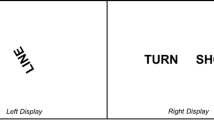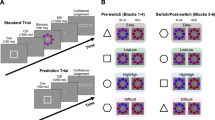Abstract
Affective valence and intensity form the core of our emotional experiences. It has been proposed that affect reflects the prediction error between expected and actual states, such that better/worse-than-expected discrepancies result in positive/negative affect. However, whether the same principle applies to progress prediction errors remains unclear. We empirically and computationally evaluate the hypothesis that affect reflects the difference between expected and actual progress in forming a perceptual decision. We model affect within an evidence accumulation framework where actual progress is mapped onto the drift-rate parameter and expected progress onto an expected drift-rate parameter. Affect is computed as the difference between the expected and actual amount of accumulated evidence. We find that expected and actual progress both influence affect, but in an additive manner that does not align with a prediction error account. Our computational model reproduces both task behavior and affective ratings, suggesting that sequential sampling models provide a promising framework to model progress appraisals. These results show that although affect is sensitive to both expected and actual progress, it does not reflect the computation of a progress prediction error.



Similar content being viewed by others
References
Bates, D., Maechler, M., Bolker, B., Walker, S., Christensen, R. H. B., Singmann, H., Dai, B., Scheipl, F., & Grothendieck, G. (2009). Package ‘lme4’. URL Http://Lme4. r-Forge. r-Project. Org.
Brysbaert, M., & Stevens, M. (2018). Power analysis and effect size in mixed effects models: A tutorial. Journal of cognition, 1(1).
Carver, C. S. (2015). Control processes, priority management, and affective dynamics. Emotion Review, 7(4), 301–307.
Carver, C. S., Lawrence, J. W., & Scheier, M. F. (1996). A control-process perspective on the origins of affect.
Carver, C. S., & Scheier, M. F. (1990). Origins and functions of positive and negative affect: A control-process view. Psychological Review, 97(1), 19.
Carver, C. S., & Scheier, M. F. (2013). Goals and emotion. Guilford Handbook of Cognition and Emotion, 176–194.
Chetverikov, A., & Kristjánsson, Á. (2016). On the joys of perceiving: Affect as feedback for perceptual predictions. Acta Psychologica, 169, 1–10.
Clark, A. (2013). Whatever next? Predictive brains, situated agents, and the future of cognitive science. Behavioral and Brain Sciences, 36(3), 181–204.
De Leeuw, J. R. (2015). jsPsych: A JavaScript library for creating behavioral experiments in a web browser. Behavior Research Methods, 47, 1–12.
Desender, K., Ridderinkhof, K. R., & Murphy, P. R. (2021). Understanding neural signals of post-decisional performance monitoring: An integrative review. Elife, 10, e67556.
Desender, K., Vermeylen, L., & Verguts, T. (2022). Dynamic influences on static measures of metacognition. Nature Communications, 13(1), 4208.
Drugowitsch, J., & Pouget, A. (2012). Probabilistic vs. non-probabilistic approaches to the neurobiology of perceptual decision-making. Current Opinion in Neurobiology, 22(6), 963–969.
Eldar, E., Rutledge, R. B., Dolan, R. J., & Niv, Y. (2016). Mood as representation of momentum. Trends in Cognitive Sciences, 20(1), 15–24.
Emanuel, A., & Eldar, E. (2022). Emotions as computations. Neuroscience & Biobehavioral Reviews, 104977.
Fleming, S. M., & Daw, N. D. (2017). Self-evaluation of decision-making: A general Bayesian framework for metacognitive computation. Psychological Review, 124(1), 91.
Givon, E., Itzhak-Raz, A., Karmon-Presser, A., Danieli, G., Meiran, N. (2020). How does the emotional experience evolve? Feeling generation as evidence accumulation. Emotion 20(2), 271.
Gold, J. I., & Shadlen, M. N. (2007). The neural basis of decision making. Annual Review of Neuroscience, 30, 535–574.
Hesp, C., Smith, R., Parr, T., Allen, M., Friston, K. J., & Ramstead, M. J. (2021). Deeply felt affect: The emergence of valence in deep active inference. Neural Computation, 33(1), 1–49.
Inzlicht, M., Shenhav, A., & Olivola, C. Y. (2018). The effort paradox: Effort is both costly and valued. Trends in Cognitive Sciences, 22(4), 337–349.
Joffily, M., & Coricelli, G. (2013). Emotional valence and the free-energy principle. PLoS Comput Biology, 9(6), e1003094.
Khalvati, K., Kiani, R., & Rao, R. P. (2021). Bayesian inference with incomplete knowledge explains perceptual confidence and its deviations from accuracy. Nature Communications, 12(1), 5704.
Klein, C. (2018). What do predictive coders want? Synthese, 195(6), 2541–2557.
Kuppens, P., Allen, N. B., & Sheeber, L. B. (2010). Emotional inertia and psychological maladjustment. Psychological Science, 21(7), 984–991. https://doi.org/10.1177/0956797610372634
Kurzban, R. (2016). The sense of effort. Current Opinion in Psychology, 7, 67–70.
Kuznetsova, A., Brockhoff, P. B., & Christensen, R. H. B. (2015). Package ‘lmertest’. R Package Version, 2(0), 734.
Loossens, T., Mestdagh, M., Dejonckheere, E., Kuppens, P., Tuerlinckx, F., & Verdonck, S. (2020). The Affective Ising Model: A computational account of human affect dynamics. PLoS Computational Biology, 16(5).
Moors, A., Ellsworth, P. C., Scherer, K. R., & Frijda, N. H. (2013). Appraisal theories of emotion: State of the art and future development. Emotion Review, 5(2), 119–124.
Moors, A., Van de Cruys, S., & Pourtois, G. (2021). Comparison of the determinants for positive and negative affect proposed by appraisal theories, goal-directed theories, and predictive processing theories. Current Opinion in Behavioral Sciences, 39, 147–152.
Mulder, M. J., Wagenmakers, E.-J., Ratcliff, R., Boekel, W., & Forstmann, B. U. (2012). Bias in the brain: A diffusion model analysis of prior probability and potential payoff. Journal of Neuroscience, 32(7), 2335–2343.
Mullen, K., Ardia, D., Gil, D. L., Windover, D., & Cline, J. (2011). DEoptim: An R package for global optimization by differential evolution. Journal of Statistical Software, 40(6), 1–26.
Pleskac, T. J., & Busemeyer, J. R. (2010). Two-stage dynamic signal detection: A theory of choice, decision time, and confidence. Psychological Review, 117(3), 864.
Proust, J. (2014). The representational structure of feelings. In Open MIND. Open MIND. MIND Group.
Rajananda, S., Lau, H., & Odegaard, B. (2018). A random-dot kinematogram for web-based vision research. Journal of Open Research Software, 6(1).
Ratcliff, R., Smith, P. L., Brown, S. D., & McKoon, G. (2016). Diffusion decision model: Current issues and history. Trends in Cognitive Sciences, 20(4), 260–281.
Russell, J. A. (2009). Emotion, core affect, and psychological construction. Cognition and Emotion, 23(7), 1259–1283.
Rutledge, R. B., Skandali, N., Dayan, P., & Dolan, R. J. (2014). A computational and neural model of momentary subjective well-being. Proceedings of the National Academy of Sciences, 111(33), 12252–12257. https://doi.org/10.1073/pnas.1407535111
Scherer, K. R. (2009). The dynamic architecture of emotion: Evidence for the component process model. Cognition and emotion, 23(7), 1307–1351.
Shenhav, A., Botvinick, M. M., & Cohen, J. D. (2013). The expected value of control: An integrative theory of anterior cingulate cortex function. Neuron, 79(2), 217–240.
Smith, R., Ramstead, M. J., & Kiefer, A. (2022). Active inference models do not contradict folk psychology. Synthese, 200(2), 81.
Uusberg, A., Taxer, J. L., Yih, J., Uusberg, H., & Gross, J. J. (2019). Reappraising reappraisal. Emotion Review, 11(4), 267–282.
Van de Cruys, S. (2017). Affective value in the predictive mind. MIND Group.
Van de Cruys, S., Bervoets, J., & Moors, A. (2022). Preferences need inferences: Learning, valuation, and curiosity in aesthetic experience. In The Routledge international handbook of Neuroaesthetics (pp. 475–506). Routledge.
Van Marcke, H., Denmat, P. L., Verguts, T., & Desender, K. (2022). Manipulating prior beliefs causally induces under-and overconfidence. BioRxiv, 2022–2003.
Velasco, P. F., & Loev, S. (2020). Affective experience in the predictive mind: A review and new integrative account. Synthese, 1–36.
Velasco, P. F., & Loev, S. (2022). Cognitive feelings in the predictive mind: Emotion Meta-cognition and Predictive Processing.
Villano, W. J., Otto, A. R., Ezie, C. E., Gillis, R., & Heller, A. S. (2020). Temporal dynamics of real-world emotion are more strongly linked to prediction error than outcome. Journal of Experimental Psychology: General, 149(9), 1755.
Open practices statement
The data, experiment and analysis code are available at https://osf.io/z85td/. The experiment was not preregistered.
Funding
This research was supported by a CELSA grant from the KU Leuven (CELSA/21/010) and Estonian Research Council grant PSG525.
Author information
Authors and Affiliations
Corresponding author
Additional information
Publisher’s Note
Springer Nature remains neutral with regard to jurisdictional claims in published maps and institutional affiliations.
Rights and permissions
Springer Nature or its licensor (e.g. a society or other partner) holds exclusive rights to this article under a publishing agreement with the author(s) or other rightsholder(s); author self-archiving of the accepted manuscript version of this article is solely governed by the terms of such publishing agreement and applicable law.
About this article
Cite this article
Voodla, A., Uusberg, A. & Desender, K. Affective valence does not reflect progress prediction errors in perceptual decisions. Cogn Affect Behav Neurosci 24, 60–71 (2024). https://doi.org/10.3758/s13415-023-01147-8
Accepted:
Published:
Issue Date:
DOI: https://doi.org/10.3758/s13415-023-01147-8




